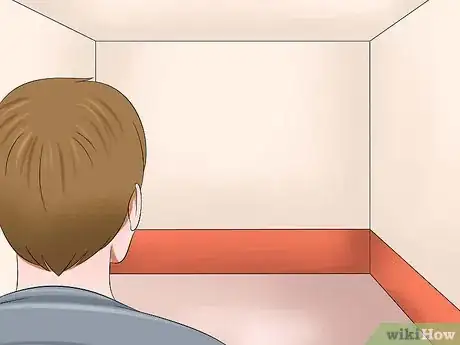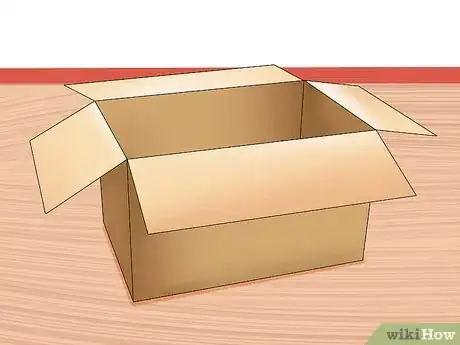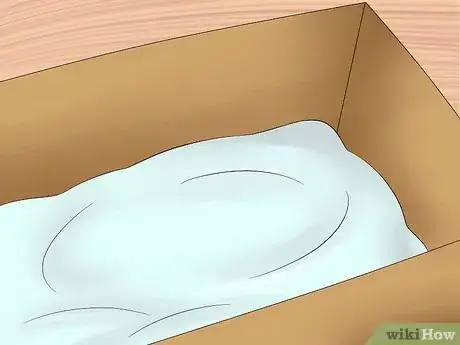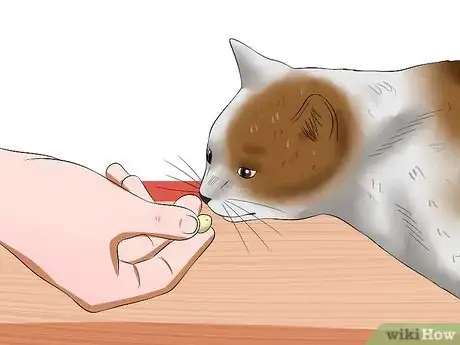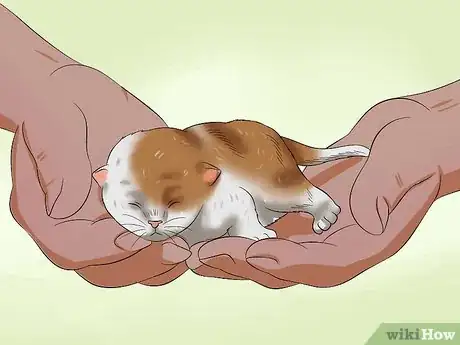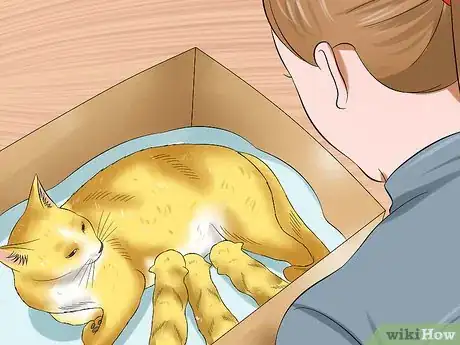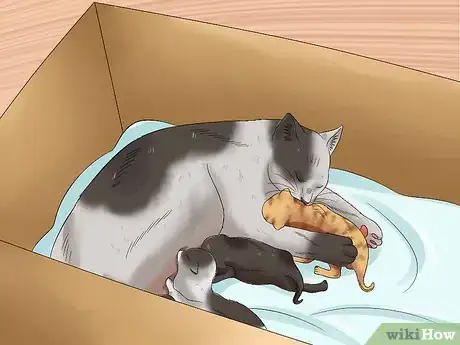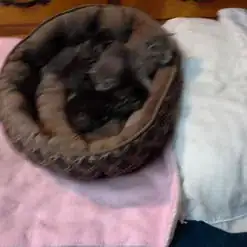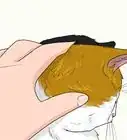This article was co-authored by Pippa Elliott, MRCVS. Dr. Elliott, BVMS, MRCVS is a veterinarian with over 30 years of experience in veterinary surgery and companion animal practice. She graduated from the University of Glasgow in 1987 with a degree in veterinary medicine and surgery. She has worked at the same animal clinic in her hometown for over 20 years.
wikiHow marks an article as reader-approved once it receives enough positive feedback. This article received 15 testimonials and 95% of readers who voted found it helpful, earning it our reader-approved status.
This article has been viewed 203,897 times.
Generally, a mother cat will seek out a safe place to birth her kittens. When she chooses a place, she generally has a set of particular things she is looking for: quiet, dark, dry, warm and safe from predators, male cats or nosy humans. Occasionally, cats don’t make the wisest of decisions due to naiveté, changing circumstances, or just a bad choice. If this is the case, you may find yourself having to make the decision to move the kittens to a better spot to keep them safe.[1]
Steps
Preparing to Move Newborn Kittens
-
1Pick a new spot for the mother and kittens. Ask yourself some questions prior to the move. Can you close the new area off to keep the mother from moving the kittens? Will the area be able to hold a litter box for the mother so she can relieve herself? Is there a safe spot (well away from the litter box) to place her water and food bowls?
- The chosen area also need to be quiet. This means away from the general hub-bub of the house, out of reasonable earshot of televisions, phones, and radios.
- It needs to be out of drafts and if the weather is chilly or the air conditioner on it needs to be at a reasonable temperature: between 75-80 degrees is ideal. Closets in guest or seldom used bedrooms work well, as does a quiet corner of a laundry or mud room. Basements, as long as they are dry and warm, are also a good choice to relocate a kitten nest.
-
2Make a new nest once your spot is chosen. A sturdy cardboard box as long and wide as the mother cat makes a great nest. Laundry baskets can also make a good nest provided the openings are less than an inch wide. If they are any bigger the kittens can potential slip through putting them in danger of injury or chilling.Advertisement
-
3Line the container with a clean, thick towel, blanket, or discarded clothing. Place it in the quiet spot, then set up the cat’s litter box, food and water bowls. You want to make the spot inviting for the mother cat just as much as you want to make the nest safe and warm for the kittens.
Relocating Newborn Kittens
-
1Have the mother come out of her current spot by enticing her with some tasty treat. Small bits of cooked chicken or a tablespoon of canned tuna might work. You want to lure her out of the nest but you also don't want to take her completely away. It's important for her to see what you are doing, but from a small distance.
-
2Pick the kittens up out of their old nest, making sure to securely handle them to prevent them from falling to the floor. Kittens cry when being handled to attract the mother’s attention. Don’t let their mews discourage you from moving them to a safe spot.[2]
-
3Have the mother follow you into the new spot. Let her watch as you set the kitten down. She should be allowed to follow the kittens into the new nest.
- Some mother cats resent having their kittens touched and may be aggressive. Wear long sleeves, pants and thick gloves if you suspect the mother might try to protect her kittens when you move them.[3]
-
4Keep newborn kittens and the mother in place. Once all the kittens and their mother are in the new nest, close the door to the area. Check them infrequently throughout the day to let the family adjust to their new surroundings.[4]
- The mother cat will probably not like the new spot, and may try to move and hide the kittens again. Keeping this in mind, choose a spot where you can keep the mother from doing so by closing a door.
- Feeding the mother tasty treats once or twice a day for a few days may make her more accepting of the new spot.
-
5Leave the family alone for a few days to allow them to adjust. Keep the area closed off. The mom cat may be itching to move her kittens at the first opportunity putting her family back at risk. The mother may be upset at first but she should calm down gradually. Make sure she and the kittens have everything they need and that the mother is taking good care of the kittens.
References
- ↑ The Behaviour of the Domestic Cat. John W. S. Bradshaw. CABI. 2012
- ↑ The Domestic Cat: The Biology of its Behaviour. Turner, D.C. and Bateson P. Cambridge University Press. 2013
- ↑ The Domestic Cat: The Biology of its Behaviour. Turner, D.C. and Bateson P. Cambridge University Press. 2013
- ↑ The Domestic Cat: The Biology of its Behaviour. Turner, D.C. and Bateson P. Cambridge University Press. 2013
About This Article
Before you move newborn kittens, make sure you have a quiet, warm, safe place to move them to, like the closet of a guest bedroom or in the corner of your laundry room. Once you've chosen a spot, set up a new nest for the mother and kittens by lining a container with a clean, thick towel or blanket. When you're ready to move the kittens, distract the mother with some treats and then carefully pick the kittens up out of their old nest. Let the mother follow you as you move the kittens so she knows where you're taking them. To learn how to deal with an aggressive mother cat, scroll down!
